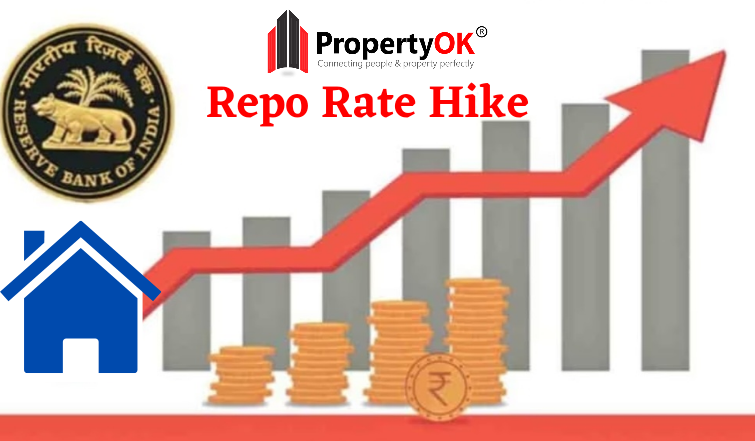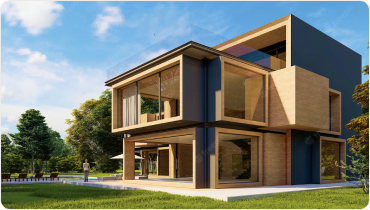Every time you’re planning to take home loans, the first thing you need to think about is the interest rate. It is one such factor that significantly impacts a financial decision. Buying a dream home is one of the biggest financial investments because it involves a huge amount of money transactions.
Also read: Most recent property rates in Mumbai
The borrowers witnessed a golden period in the last couple of years because they got the lowest home loan interest rate, resulting in a Repo rate hike. However, time seems to be changing due to rising inflation after the Covid-19 pandemic lockdown. This article will explain how repo rate hikes affect home loan interest rates and homebuyers.
What is the Repo rate?
Repo stands for Repurchasing Option or Repurchase Agreement. Repo rate is the interest rate at which the central bank, i.e., the Reserve bank of India (RBI), lends money to commercial banks. RBI uses the repo rate to control inflation. In addition, commercial banks take a one-day loan from RBI by selling RBI-approved securities when they face a shortage of funds or need to preserve liquidity in volatile market conditions.
An agreement between the commercial bank and the central bank is made to repurchase the securities at the determined price. During inflation, RBI increases the repo rate, which makes it difficult for the banks to borrow money from it, resulting in the reduction of the cash flows in the economy. During deflation, the repo rate decreases, increasing cash flows in the economy because credit becomes cheaper.
The Repo rate increase by RBI is to remove the excess money supply from the market. The reverse repo rate is the rate of interest at which the deposit is kept with the central bank by the commercial bank. RBI holds quarterly meetings to declare the repo rate change for the quarter.
Effect of a Repo rate hike in the real estate sector
The repo rate hike does not portend well for the real estate sector because it will increase mortgage rates. This is because home loan rates are immediately increasing. Since the earlier RBI repo rate hike in May, the banks have already increased home loan interest rates by 30-40 bps, and now that the repo rate is 90 bps higher, there will be a further increase in the home loan rates. Read further to know the impacts of repo rate hikes in the real estate sector.
The recent decision by RBI to hike the repo rate by 50 basis points, considering the cumulative rates hiked to 90 bps in just 30 days, is expected to impact the rate at which the real estate market has been growing. However, residential sales might witness less downside because the demand remains strong and has been flowing.
With the first repo rate hike in May, there’s an increase in home loan interest rates which is helping the real estate industry to excel pre-covid-19 phase resulting in record-breaking sales. The residential property market made an excellent comeback despite the onset of the pandemic was driven by a reduction in stamp duty and other incentives and low-interest rates offered by the developers.
The RBI interest rate hike will also impact the residential sales growth in the short term. The developers also increased real estate prices with the continuous rise in the cost of raw materials. However, the industry people feel that homebuyers will continue to invest in real estate because they understand that these factors are beyond the developers’ control.
Also Read: The Most Common Doubts regarding GST on real estate.
On the positive side, the increase in demand and the ability of the consumer to afford will remain on the bright side. However, the fixed interest rates might shake the sales momentum with the recovery in the real estate industry. The RBI is now taking appropriate measures to ensure the recovery of the domestic economy. The real estate industry will surely be affected by focusing on financing aspects such as home loans and consumer loans, getting a little costlier.
What is the impact of a Repo rate hike on homebuyers?
When a home loan is taken at a floating rate, you are borrowing it at the current market rate with the condition that you’ll repay the loan as per the current market rate. Today most home loans are linked to the repo rate-based lending rate, which means whenever repo rates rise, the floating rate home loans will become costly, resulting in a sequential rise in the EMIs.
The RBI has raised the interest rate for the third time by 50 basis points to 5.40%. So far, the total hike in 2022 stands at 140 basis points, raising the total cut of 115 basis points passed in 2020. These rate hikes will control the high liquidity pumped into the market in 2020 and tame inflation.
With this hike, the current borrowers on floating rate loans would witness their loan current increase. You can evaluate your home loan rate by checking the premium you are paying, exceeding the repo rate. This premium varies from lender to lender. Hence, the range could be higher or lower depending on who you are and from whom you borrow.
You are always advised to pre-pay your home loan either partially or fully regularly. You will significantly reduce an increased interest rate burden if you pre-pay 5% yearly. The existing borrowers can refinance to a lower interest rate or avoid paying more interest on their existing loans by increasing their EMIs.
Impact of Repo rate on home loan interest rates
The cost of borrowing for banks goes down when RBI lowers the repo rate. So, the banks are expected to eventually pass on this benefit to the buyers. Due to the Covid-19 outbreak and its adverse economic impact, the bank has implemented a 200 basis point reduction by bringing the repo rate down to 4% over the past 12 months. The banks have also started supporting the buyers by lowering the home loan interest rates.
The State Bank of India has recently reduced its repo rate-linked home loan interest rate to 6.95%. Furthermore, home loan interest rates rise with the RBI’s lending rate hike. By the way, banks are generally very slow in reducing their lending rates and are quicker in passing on the increase in lending rates to their customers.
So, the changes in the repo rate should be immediately reflected in the interest rates of the financial institutions, but only increases are seen, and the RBI has to poke the banks to reduce rates to borrowers. Currently, all the banks in India are offering home loans linked to the RBIs repo rate.
The RBI has introduced a Marginal cost of fund-based lending rates regime or MCLR under which the banks have to follow RBI guidelines while charging interest rates, and the charges cannot be less than the limit stated by RBI to change the way commercial lenders function. This ensures that the borrowers can benefit from home loan repo rate reductions.
The banks must also inform the customers about the new home loan interest rates every month until 5 years. Under this regime, the EMI and repo rate will have a stronger relationship because while lending funds; the banks cannot have a margin higher than 25 basis points.
Current Repo rate in India
On 30th September 2022, the Reserve Bank of India (RBI) announced that RBI’s Monetary Policy Committee (MPC) raised the repo rate by 50 basis points to 5.90%. This is the fourth consecutive repo rate that has been hiked this fiscal. Increasingly, in this financial year, the RBI has a repo rate hike by 190 basis points.
The bottom line
According to the RBI data, home loans constitute around 65% of India’s outstanding bank loans. Most borrowers opt for floating-rate loans that are affected by repo rate hikes. The ideal approach of the homebuyer should be to budget the expense well in advance to prevent defaulting on a loan.
For more insights, go to the PropertyOK blog page.
Frequently Asked Questions
1. How does the repo rate affect home loans?
For existing borrowers, the home loan rates equally increase with an increase in repo rate because the rates are directly linked with it, and the new buyers borrow home loans at rates fixed by banks adjusting for a repo rate hike.
2. What is the impact of a repo rate hike on consumers?
When funds are scarce in the banks, the bank borrows money from the central bank to satisfy their credit demand. So, the customers will have to pay more when borrowing money from banks because of the hike in the repo rate.
3. What happens if the repo rate decreases?
A decrease in the repo rate means that the interest rate charged on home loans and EMIs also decreases because interest rates and lending rates are linked with the repo rate. Thus making it easier for customers to borrow or avail of loans from banks which in turn help in the country’s economic growth.
Please add some content.


 Thank You
Thank You